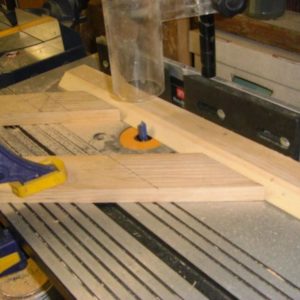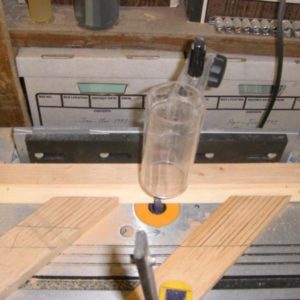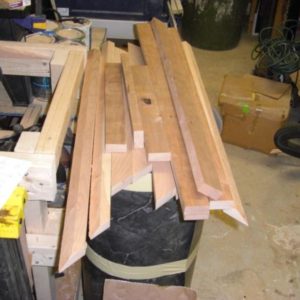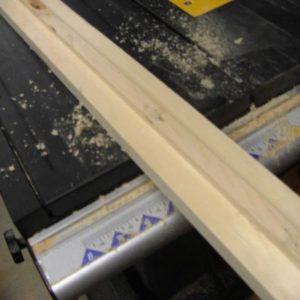here’s the next project, puppet case for a scary chinese puppet for my dad. It is out of cherry. Right now is just the case, but right after I will be making a matching table for it.
001 and 002 are a router jig to perfect the bevel because I mitered the corner first, long story. The pine beveled board it hotglued to the fence, and the board to be cut slides between the feather boards and pine. This didn’t work out too well
003 is all the wood to make the case x-cept the glass and ply.
004 and 005 is the TS jig I made to cut the bevel because the router didn’t work perfectly, Hot glue the board of beveling to the jig, and run through the blade.
there’s no need to reinvent the wrench
























Replies
Looks like a good start, got a sketch of the final project?
stay safe buddy.
Spheramid Enterprises Architectural Woodworks
Repairs, Remodeling, Restorations
"We strive for conversion,we get lost in conversation, and wallow in consternation. "
Me.
yeah I'll scan it tomorrow
Silence is golden, but ducktape is silver
I can almost smell the sawdust from here. :D
--------------------------------------------------------
Cheap Tools at MyToolbox.net
See some of my work at TedsCarpentry.com
ya gotta love that cherry
Silence is golden, but ducktape is silver
What's the scary part? Puppet so scary it has to be kept out of sight?
Nice work.
Hey Andy, If you can avoid it don't run the stock between the
bit and the fence!
You could have done that operation the other way around, just
add a piece if ply (or whatever) to the infeed side and then set the
the fence in relation to the bit. You obviously did fine, but that can kick the stock something
fierce.PS
The same is true for the TS. You can't always avoid it,
but whenever possible don't trap the wood between the blade and fence.
Edited 6/7/2008 4:45 pm ET by Henley
...If you can avoid it don't run the stock between the bit and the fence...
Sometimes I tend to take things too literally so maybe I'm guilty once again, but I just can't imagine the point of using a fence if the material isn't between the fence and the bit (or blade). What am I missing?
Well it's kind of a broad question.
Lots of situations to cover...
Andy's situation he was taking material off the edge of a board.
You could just as easily set the fence so only the required amount
to be removed was projecting forward.
Rather then placing the fence the given distance behind the bit.
That sounds confusing sorry. The point is there is almost always more then one way to skin a cat.
And some way's are safer then others.
As in the Table saw, tilting the blade towards the fence. Thereby trapping the stock between the blade and the fence, rather then putting the fence on the other side and flipping the stock over.
With the material between the bit and the fence, you have no way of controling how much the bit will bite into the wood. Using a featherboard or a push block will help to keep your piece against the fence but if the bit bites in the wood for some reason, it can kick back and shoot out your piece. If you are are using a bit with a 1/4" shank and it's not set properly in the collet, your bit could bend and that's just not good at 20000 rpm.
The only reason I see to put the material between the bit and the fence is if you want to shape your edge AND make your piece have a uniform width at the same time. Not a good idea. You need to use the right tools for the job. Table saw and jointer to make a straight edge and cut to width. Router or shaper to put a profile on an edge.
So why use a fence ? If you are edging or shaping straight pieces, the fence is very useful. It's a must if you're using bits without a roller bearing guide because it obviously guides your piece but also limits your depth of cut. And if you have a split fence such as this http://www.leevalley.com/shopping/TechInfo.aspx?c=1&type=a&p=42155, you can have shims on your outfeed side and use your router table as a jointer.
Edited 6/7/2008 11:48 pm ET by Chucky
Thanks. I don't use the router table a lot and when I do, I've generally used a roller guide on the bit. The router table that I have (a small bench-top style) came with a split fence, which is a nuisance to set up, but actually works pretty well.
And thanks, Henley, for the clarification on the table saw. My table saw only has a fence to one side of the blade so I can't tip the blade towards the fence if I wanted to. Not that there haven't been times that I've wanted to, but I always found an alternate solution. I can certainly see how a "trapped" piece of wood has much greater potential for becoming a projectile.
I'll repeat what Henley said, Don't run the stock between the fence and the bit.
It does appear that you were at least feeding it from the left side which puts the stock on the proper side of the bit in that situation.
If you where to run the stock in from the right in that arrangement (without the feather boards)that board would shoot out of there like a Hot Wheels car launcher.
PS: I'm still looking for that plan for you.